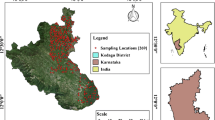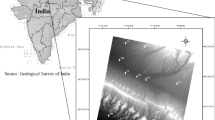Abstract
The primary goal of Cartosat-1 mission is to generate, archive and disseminate seamless Digital Elevation Model (DEM) to facilitate the Remote sensing users and cartographers. The production approach identified for generating CartoDEM is through processing based on Ground Control Points (GCPs) using Augmented Stereo Strip Triangulation (ASST) software system. DPGS-NRSC has generated and disseminated 10 m CartoDEM covering India and surrounding countries, part of south- west Asia and in the process of generating DEM covering Australia. 30 m DEM is ported on Indian EO portal Bhuvan for visualization and free download. To explore the improved performance of the DEM, we carried out comparative quality analysis of CartoDEM data with 2.5, 5 and 10 m resolutions generated in operational mode. This study has confirmed the enhanced performance of 2.5 m CartoDEM in terms of hydrological, terrain category and contour analysis. This geospatial input is one of the decision making tools for understanding spatio-temporal variations and better management.
Access provided by Autonomous University of Puebla. Download conference paper PDF
Similar content being viewed by others
Keywords
1 Introduction
Digital Elevation Model (DEM) is a digital representation of the Earth’s relief that consists of an ordered array of elevations relative to a datum, and referenced to a geographic coordinate system. A DEM can be defined as a regular two-dimensional array of height values describing the varying elevation of an area’s terrain [1].
DEMs are useful for many purposes, and are an important precondition for many applications [2]. They are particularly useful in regions that are devoid of detailed topographic maps. DEMs have been found useful in many fields of study such as geo-morphometry, as these are primarily related to surface processes such as landslides which can directly be depicted from a DEM [3], archaeology as subtle changes due to previous human activity in the sub surface can be inferred on detailed DEMs, forestry, e.g. height of trees and relation to preferred tree stem size, hydrology, like deriving drainage network and overland flow areas that contribute to suspended sediment loads and analysis of glaciers and glaciated terrains.
Several techniques and tools are suitable for DEM extraction like digital aerial and terrestrial Photogrammetry, airborne and terrestrial laser scanning, Global Positioning System (GPS) with its different measurement approaches and active and passive remote sensing, with optical satellite imagery systems.
With the launch of the Indian remote sensing satellite Cartosat-1, an along-track stereoscopic imaging mission, possibilities for operational availability of high-resolution stereo-imagery from space for the remote sensing and cartography user communities have emerged [4]. The high-resolution stereo data beamed from twin cameras onboard Cartosat-1 mission facilitates topographic mapping up to 1:25,000 scale. An initiative to generate a database of seamless, homogeneous DEM, named as CartoDEM and associated ortho-image tiles at country level has been undertaken by ISRO. CartoDEM generation system in NRSC has produced the digital surface model covering India and surrounding countries and part of South West Asia using improved software version-3. At present, DEM generation of Australia is under progress.
To explore the improved performance of the CartoDEM, generated data with 2.5, 5 and 10 m resolutions for quality assessment.
2 Quality Assessment
A comparative study is carried out to analyze the CartoDEM data with 2.5, 5 and 10 m resolutions generated in operational mode through indigenously developed software—Augmented Stereo Strip Triangulation (ASST). Sample data sets selected are covering different elevation ranges from 100 to 5700 m. Following parameters are compared between the data sets with different resolutions—DEM statistics, slope distribution statistics, spatial profiles, terrain categories, contours, stream networks and DEM derivatives (Table 1).
DEMs of the study sites were transformed into the same projection system for quantitative and qualitative assessment. Quality evaluation is done through computation of accuracy measures, visual comparison of derivatives.
Analysis and Results
Elevation range, Mean and Std. dev. of 2.5, 5 and 10 m DEMs are matching (Table 2).
Slope Distribution Statistics
Slopes are derived for all the DEM tiles and slope distribution statistics like maximum slope, average slope and std. dev. are computed. It is observed that maximum and average slopes are matching. Standard deviation of 2.5 m DEM slope is more than 5 and 10 m which shows the presence of subtle details (Table 3).
Surface Spatial Profiles
The spatial horizontal profiles were extracted for the cells that fall along the horizontal cursor line (red) of all three DEM tiles and compared. A graph of elevation profile was produced for comparison. It observed that 2.5 m DEM shows better details in areas of higher elevation range (Fig. 1) and no significant variation in details in plain areas of 2.5 m, 5 m and 10 m DEMs.
Terrain Category Analysis
Terrain analysis employs the digital elevation data in conjunction with other geospatial information like slope, aspect and relief to describe the landscape for visualization. It is evident from Fig. 2 that significant details are extracted in 2.5 m DEM than 5 m and 10 m DEMs.
Hydrological Analysis
The hydrologic tools allow to determining the flow direction, calculating flow accumulation, delineating watersheds, and creating stream networks. Stream networks can be delineated from a DEM using the output from the Flow Accumulation function. Flow accumulation in its simplest form is the number of upslope cells that flow into each cell. More lower order streams are delineated in 2.5 m DEM. Visual inspection of delineated streams (Fig. 3) shows that 2.5 m DEM has more details than 5 and 10 m DEMs.
Contour Analysis
Contours are polylines that connect points of equal elevation values and useful for surface representation. They allow simultaneous visualization of flat and steep areas, ridges and valleys. Contours are derived for all the DEM tiles with 10 m interval and overlaid for comparison. The distribution of polylines shows how values change across a surface. The 2.5 m DEM contours appear smooth without any rapid fall (Fig. 4).
Visual Comparison of Derivatives
DEM derivatives like slopes, aspects and terrain relief maps are generated for all data sets and compared.Visual comparison of Figs. 5, 6, 7 confirms that 2.5 m DEM has more details in areas of higher elevation range.
3 Discussion and Conclusions
From the spatial profiles, 2.5 m DEMs show better details in areas of higher elevation range. No significant variation in plain areas of 2.5, 5 and 10 m DEMs. From terrain category analysis, significant details of areas with a particular slope and aspect are visible in 2.5 m DEM than 5 and 10 m DEMs. Visual comparison of derivatives like slope, aspect, relief shaded maps confirms that 2.5 m DEM has more details in areas of higher elevation range. Elevation range, mean, std. dev. are matching in three resolution DEMs.
From Slope distribution statistics, Maximum and average slopes are matching. Std. dev. of 2.5 m DEM slope is more than 5 and 10 m which shows the presence of subtle details. From Hydrological analysis, 2.5 m DEM depicts more flow accumulation details than 5 and 10 m DEMs. From Contours analysis, 2.5 m DEM depicts more details than 5 and 10 m DEMs. From the results interpretation, DEMs generated from coarsely sampled elevation points may have severe limitations in their use for hydrological analysis. The performance of the DEM depends on its spatial resolution and the landscape it represent. This study has confirmed the enhanced performance of 2.5 m CartoDEM in terms of hydrological, terrain category and contour analysis. DEM interpretation based on resolution which contains details about sampled point elevations will be taken up for the future work.
References
Burrough, P.A., McDonnell, R.A.: Principles of geographical information systems, pp. 333–335. Oxford University Press, New York (1998)
Kim, S., Kang, S.: Automatic generation of a SPOT DEM: Towards coastal disaster monitoring. Korean J Remote Sens. 17, 121–129 (2001)
Pike, R.J., Evans, I.S., Hengl, T.: Geomorphometry: A brief guide
Srivastava, P.K., Srinivasan, T.P., Gupta, A., Singh, S., Nain, J.S., Amitabh, Prakash, S., Kartikeyan, B., Krishna, B.G.: Recent advances in Cartosat-1 data processing. ISPRS Hannover Workshop (2007)
Acknowledgements
The authors would like to place on record their deep gratitude for the support provided by Dr. Y. V. N. Krishnamurthy, Director, NRSC for the successful completion of this work. The authors deeply acknowledge the support provided by CartoDEM generation team.
Author information
Authors and Affiliations
Corresponding author
Editor information
Editors and Affiliations
Rights and permissions
Copyright information
© 2019 Springer International Publishing AG, part of Springer Nature
About this paper
Cite this paper
Venkateswarlu, E., Raghuramulu, I., Sivannarayana, T., Swamy, G.P., Gopala Krishna, B. (2019). Quality Evaluation of CartoDEM in Different Resolutions. In: Rao, P., Rao, K., Kubo, S. (eds) Proceedings of International Conference on Remote Sensing for Disaster Management. Springer Series in Geomechanics and Geoengineering. Springer, Cham. https://doi.org/10.1007/978-3-319-77276-9_8
Download citation
DOI: https://doi.org/10.1007/978-3-319-77276-9_8
Published:
Publisher Name: Springer, Cham
Print ISBN: 978-3-319-77275-2
Online ISBN: 978-3-319-77276-9
eBook Packages: EngineeringEngineering (R0)











